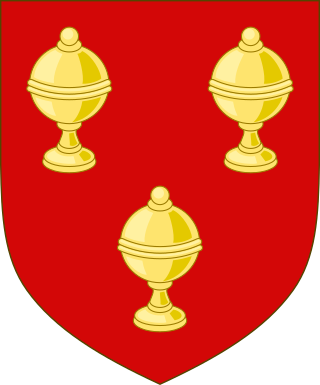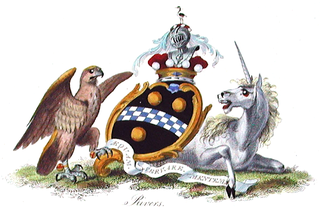Duke of Buckingham, referring to Buckingham, is an extinct title that has been created several times in the peerages of England, Great Britain, and the United Kingdom. There were creations of double dukedoms of Buckingham and Normanby and of Buckingham and Chandos. The last holder of the dukedom died in 1889.

Marquess of Rockingham, in the County of Northampton, was a title in the Peerage of Great Britain. It was created in 1746 for Thomas Watson-Wentworth, 1st Earl of Malton. The Watson family descended from Lewis Watson, Member of Parliament for Lincoln. He was created a Baronet, of Rockingham Castle in the County of Northampton, in the Baronetage of England in 1621. In 1645 he was further honoured when he was raised to the Peerage of England as Baron Rockingham. The third Baron served as Lord-Lieutenant of Kent. In 1714 he was created Baron Throwley, Viscount Sondes and Earl of Rockingham in the Peerage of Great Britain. His eldest son Edward Watson, Viscount Sondes, predeceased him and he was succeeded by his grandson, the second Earl. The second Earl was Lord-Lieutenant of Kent before his early death in 1745. He was childless and was succeeded by his younger brother, Thomas. He had previously represented Canterbury in Parliament.
The Peerage of the United Kingdom is one of the five Peerages in the United Kingdom. It comprises most peerages created in the United Kingdom of Great Britain and Ireland after the Acts of Union in 1801, when it replaced the Peerage of Great Britain. New peers continued to be created in the Peerage of Ireland until 1898

Viscount Cobham is a title in the Peerage of Great Britain that was created in 1718. Owing to its special remainder, the title has passed through several families. Since 1889, it has been held by members of the Lyttelton family.

Marquess Townshend is a title in the Peerage of Great Britain held by the Townshend family of Raynham Hall in Norfolk. The title was created in 1787 for George Townshend, 4th Viscount Townshend.

Marquess of Bath is a title in the Peerage of Great Britain. It was created in 1789 for Thomas Thynne, 3rd Viscount Weymouth. The Marquess holds the subsidiary titles Baron Thynne, of Warminster in the County of Wiltshire, and Viscount Weymouth, both created in 1682 in the Peerage of England. He is also a baronet in the Baronetage of England.

Marquess of Londonderry, of the County of Londonderry, is a title in the Peerage of Ireland.

Earl of Halifax is a title that has been created four times in British history—once in the Peerage of England, twice in the Peerage of Great Britain, and once in the Peerage of the United Kingdom. The name of the peerage refers to Halifax, West Yorkshire.

Earl of Powis (Powys) is a title that has been created three times. The first creation came in the Peerage of England in 1674 in favour of William Herbert, 3rd Baron Powis, a descendant of William Herbert, 1st Earl of Pembroke. In 1687, he was further honoured when he was made Marquess of Powis.

Earl of Plymouth is a title that has been created three times: twice in the Peerage of England and once in the Peerage of the United Kingdom.

The peerage title Earl of Ormond and the related titles Duke of Ormonde and Marquess of Ormonde have a long and complex history. An earldom of Ormond has been created three times in the Peerage of Ireland.

Earl of Yarmouth is a title that has been created three times in British history, once in the Peerage of England and twice in the Peerage of Great Britain. The first creation came in the Peerage of England in 1679 in favour of the politician and scientist Robert Paston, 1st Viscount Yarmouth. He had already been created Baron Paston and Viscount Yarmouth in the Peerage of England in 1673. He was the son of William Paston, who had been created a Baronet, of Oxnead in the County of Norfolk, in the Baronetage of England in 1641. Lord Yarmouth was succeeded by his son, the second Earl. He notably served as Treasurer of the Household between 1687 and 1689. He had no surviving male issue and the titles became extinct on his death in 1732.

Earl of Chatham, of Chatham in the County of Kent, was a title in the Peerage of Great Britain. It was created in 1766 for William Pitt the Elder on his appointment as Lord Privy Seal, along with the subsidiary title Viscount Pitt, of Burton Pynsent in the County of Somerset, also in the Peerage of Great Britain.

Thomas Innes Pitt, 1st Earl of Londonderry was a British Army officer, speculator and Whig politician who sat in the House of Commons from 1713 to 1728. He served as Governor of the Leeward Islands from 1728 to his death in 1729.

Earl of Norwich was a title that was created four times in British history, three times in the Peerage of England and once in the Peerage of Great Britain. The first creation came in the Peerage of England in 1626 in favour of the courtier and politician Edward Denny, 1st Baron Denny. He had already been created Baron Denny, of Waltham in the County of Essex, in 1604, also in the Peerage of England. Lord Norwich was the grandson of Sir Anthony Denny, confidant of Henry VIII, and the nephew of Sir Edward Denny. He had no sons and the titles became extinct on his death in 1630.

Earl of Bellomont, in the Kingdom of Ireland, was a title that was created three times in the Peerage of Ireland. The first creation came on 9 December 1680 when Charles Kirkhoven, 1st Baron Wotton, was made Earl of Bellomont. He had already been created Baron Wotton, of Wotton in the County of Kent, in the Peerage of England on 31 August 1650. He was childless and both titles became extinct on his death in 1683.

Baron Rivers was a title that was created four times in British history, twice in the Peerage of England, once in the Peerage of Great Britain and once in the Peerage of the United Kingdom.

Baron Camelford, of Boconnoc, in the County of Cornwall, was a title in the Peerage of Great Britain. It was created, as Lord Camelford, Baron of Boconnoc, on 5 January 1784 for Thomas Pitt, who had previously represented Old Sarum and Okehampton in Parliament. A member of the famous Pitt family, he was the eldest son of Thomas Pitt of Boconnoc; a great-grandson of Thomas Pitt, President of Madras, who purchased Boconnoc House; a great-nephew of Thomas Pitt, 1st Earl of Londonderry; a nephew of William Pitt, 1st Earl of Chatham and first cousin of William Pitt the Younger. Lord Camelford was also the father-in-law of William Grenville, 1st Baron Grenville. The title became extinct on the death of his only son, the 2nd Baron, who was killed in a duel in 1804.

Ridgeway Pitt, 3rd Earl of Londonderry of Soldon in the parish of Holsworthy in North Devon, was a British politician and peer.
Robert Ridgeway, 4th Earl of Londonderry was an Anglo-Irish peer.












